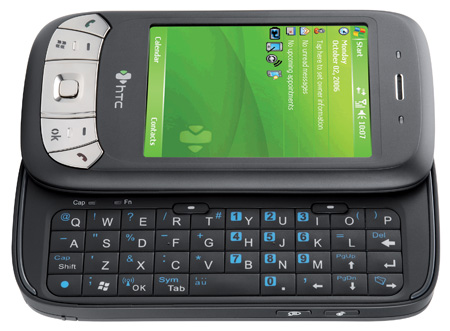This article is more than 1 year old
HTC P4350 Communicator
Simplicity seems to be the selling point
Under the hood, there's a TI OMAP 850 application processor running at 201Mhz, an ideal trade-off between performance and uptime. HTC claims a battery life of five hours in use and 200 hours standby time - which weren't far off the mark and may have been more than adequate a year ago. The surprise success of Nokia's E61, however, puts it in the shade. The E61 is lighter than the P4350 yet boasts a larger battery and superior power management: giving it nine hours talk time on GSM/GPRS networks, and all-day (and longer) always-on WLAN, so it can be permanently set as a VoIP phone.
In practice, the HTC performed well as a PDA, and better than expected overall, but radio communications (voice and WLAN) really drained the battery. The slideout keyboard, given the limited space, feels cramped, and although it's backlit, there's no sensor. The user must type in the dark to activate the keyboard although Windows Mobile offers a wider choice of pen entry methods than competitive platforms.
The 38-key thumb board sports two additional hard buttons for activating the softkeys, but we found it too easy to press these accidentally while typing: there's no special dispensation given to the Start or OK keys, the two most important keys on the device.
The P4350 excelled in some areas, but the overall user experience was disjointed and confusing. Let's start with two things it does very well.
Contacts look-up is much more efficient than in UIQ or Nokia's S60. The Contacts applications performs substring matches on any field, not just first name or last name, and not just on the initial letters of the name. It also performs "first initial firstname - first initial lastname" lookups that have proved so popular on Palm's Treo range.
Once configured, ActiveSync also performed smoothly and reliably. We also liked the SMS notifications, which tell you who the sender is, and the first line of the text message, without any user intervention. Since it can take 10 seconds or more to view the contents of a text message on some of Nokia's S60 phones, one wonders why rivals couldn't incorporate this feature, as it saves a great deal of time.

Not by accident, all three positives derive from one team, or a team within one organisation: Microsoft itself.
However, in many other areas it appears Windows Mobile had been thrown together by teams who'd never met – even until the release of the product. And apparently, no top-down oversight in the Q&A department spotted these anomalies.
While SMS notifications are helpful, other instances of Windows Mobile notifications are quite infuriating. For example, the device informs the user that it's receiving data. It doesn't say how much or how fast, as there's no progress display. The Dialog contains a "Hide" option but can't be "hidden", nor can it be moved.
In another instance of poor quality control, for example, the basic WLAN configuration offers two almost-identical control panel icons, one labelled "Wi-Fi" and the other "WLAN". One turned out to be a near replica of the Windows XP network dialog box, the other a formidable five-tab dialog, which also invited one to "enroll". And additional "Comms Manager" pane simply led to one or the other.
